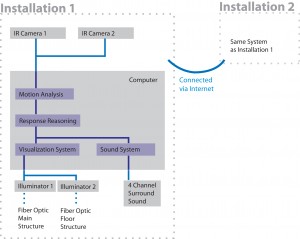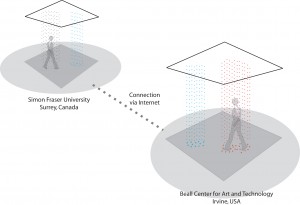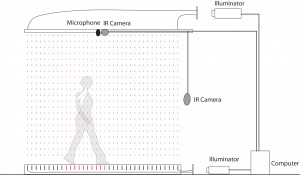Halcyon
Proposal for Beall Center for Art and Technology (2008)
Collaboration With Greg Corness
Project Abstract
Halcyon explores the visitor’s perception of alterity by presenting two immersive environments networked together to share parameters of visitor’s presence along side generated media agents. The visitor’s presence is rendered by the system through light, sound and action. Fiber Optics create an immersive tactile space filled with fine threads of light while granular synthesis and other digital signal processing techniques, manipulate the visitor’s own sounds creating an audio texture. The visual and auditory environments include interactive media agents, providing for artistic tension in the confusion between the media agents and telemetric visitors.
Project description
Background of the project
Halcyon explores the visitor’s perception of alterity by presenting two immersive environments networked together to share parameters of visitor’s presence along side generated media agents. This project is an extension of a research project funded by the Social Sciences and Humanities Research Council (SSHRC) of Canada, exploring aesthetics of interaction in an immersive environment populated with media agents. In working on this project, we have noticed that although visitors were not required to perform in the space, they often chose to remain in the environment, sitting and talking with other visitors, commenting on the systems response to their conversation and presence. We intend to explore this social aspect of the work by abstracting the presence of other visitors. We wish to artistically explore, through an immersive telemetric installation, visitors perception of others in abstract digital renderings.
Presence in the system
The visitor’s physical presence is rendered by the system through light, action and sound. The immersive interactive spaces, currently being developed as part of our SSHRC project, make use of Fiber Optics embedded in the floor and hung from the ceiling in long straight strands to create an immersive tactile space filled with fine threads of light. The presence of the visitors and media agents are rendered through these glowing strands. The quality of each visitor’s motion in the space affects the media agents behavior. In this way, it is possible to perceive the presence of others through the actions of the media agents. Finally, a four-speaker surround sound system provides an acoustic environment in the space. Through the use of granular synthesis and other digital signal processing techniques, the visitor’s own sounds are manipulated and used to create sound agents which interact within the two spaces. The sounds generated by the system as well as echoes of the visitor’s original noise are fed into both spaces so that the presence of each visitor is reflected in the ambient sound space echo as well as the timbre of the audio agents.
Implementation
Halcyon would require that one space be constructed at Simon Fraser University. We would create a second environment at the BEALL Center and set up a link between the two. During the development time, we would explore two modes of connecting the spaces. The first design would consider the two spaces as sections of a single larger virtual space. In this mode the media agents with in the space could move between the two spaces, interacting with both visitors in their respective side of the virtual space. Our second mode would investigate a single space metaphor in which the virtual space is perceived as having the same dimension as each physical space. In this mode, the visitors would have light representations in the networked space in a similar manner to the media agents. This mode explores perception of alterity in two immersive environments, providing for artistic tension in the confusion between the media agents and telemetric visitors.
Installation Sketches
Two installations from Irvine and Surrey will be connected via Internet.
Technical Diagram

1. Camera-based motion tracking System
Two Firewire IR Cameras detect the participants’ motion in the installation. The light emitted by the fiber optics has a low level of Infrared spectrum. This allows the use of IR cameras for tracking the movements of visitors in the space.
2. Response Reasoning System
The main control system mediates between the motion tracking data and the musical and visual animation processes. A hybrid reasoning engine based on Bayesian Belief networks and Neural Nets will be used to program the behavior of the media agents.
3. Visual System
Abstract images rendered by the system are projected on to the ends of a bundle of fiber optics using an illuminator. Fiber optics that fills up the installation space will create tactile light space allowing light animation around the space.
4. Sound System
Four Channel Surround Speakers


